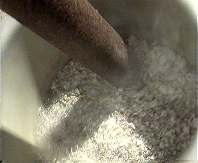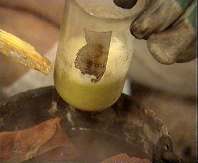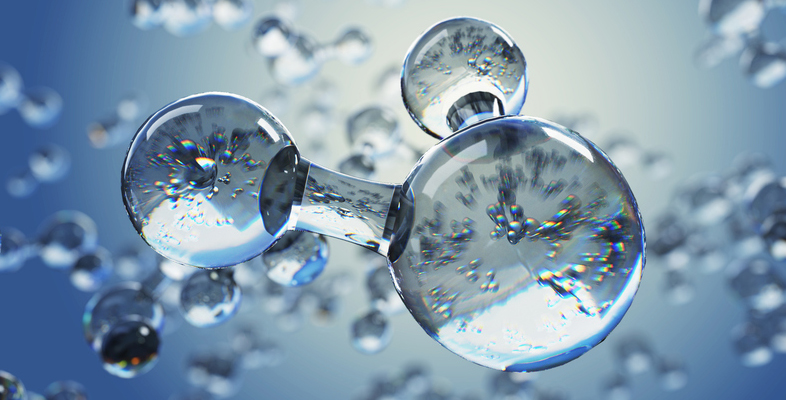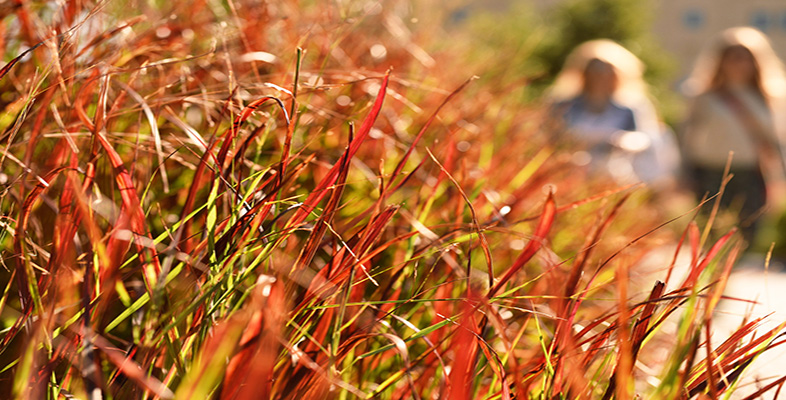Find out about The Open University's Science courses and qualifications

[The Sumerians] used a slurry of ashes and water to remove grease from raw wool and cloth so that it could be dyed. Sumerian priests and temple attendants purified themselves before sacred rites, and in the absence of soap, they too probably used ashes and water.
The slippery solutions clean because the alkali reacts with some of the grease on an object and converts it into soap. The soap then dissolves the rest of the dirt and grease. The more grease and oil dissolved by the alkaline solution, the more soap there is and the better the mixture cleans.
People would inevitably notice this because they used the slippery solutions repeatedly until the solutions lost their potency. Thus, the Sumerians, realising that a little grease improved the performance of the alkali, proceeded to make soap solutions directly by boiling fats and oils in the alkali before using it for cleaning. Specific directions for making different kinds of soap solution have been found on cuneiform tablets.’
- H. W. Salzberg, From Caveman to Chemist, American Chemical Society, Washington DC, 1991
Soaps were not to be found in early Ancient Roman baths; even Cleopatra was confined to essential oils and fine white sand (as an abrasive) for cleansing.
Ancient Roman legend has it that the word ‘soap’ is derived from Mount Sapo, where animals were sacrificed, and from where rainwater washed a mixture of melted animal fats (tallow, a foul-smelling substance also used to make candles) and wood ashes into the River Tiber below. There, the soapy mixture was found to be useful for washing clothing and skin.
By contrast, Pliny the Elder, whose writings chronicle life in the First Century AD, describes soap as ‘an invention of the Gauls for giving a reddish tint to the hair’. He even gives recipes for making soap, indicating that it was used ‘to disperse scrofulous sores’. It’s difficult to imagine the smell and discomfort associated with its early use.

Exactly when soap arrived on British shores isn’t clear, although we probably learnt the art of soapmaking from the Gauls. In the Middle Ages, artisans independently worked away at crafts like dyeing and soapmaking. Secret recipes, refined by trial and error, were handed down from master to apprentice, and from father to son. Soap was largely developed for use in the cloth industry, to prepare wool for dyeing, and not for personal hygiene.
By the 13th century, soapmaking in Britain became centred in large towns like Bristol, Coventry and London, with each making its own variety. Large areas of British woodland were destroyed to meet the growing demand for wood ashes, causing a country-wide shortage of winter fuel. Italy, Spain and France also became early soap-producing centres.
Plentiful supplies of high quality olive oil and barilla ashes (from which they made their alkali) made regions like Castile in Spain and Marseilles in France renowned for the quality of the soap they produced. The method used throughout the Middle Ages and up to the 17th century consisted of boiling olive oil (in Mediterranean countries) or animal fats (in Northern Europe) with an extract of plant ashes and lime.
In the 16th century, three broad varieties of soap were available: coarse soap made from train oil (extracted from whale blubber), sweet soap from olive oil and speckled soap from tallow. For a while, the making of speckled soap was forbidden, not simply because it smelt so bad but because its manufacture would deplete the nation’s tallow reserves, thereby driving up the cost of candles beyond the reach of the poor.
As a result, soap was heavily taxed and became a luxury item only readily available to the rich. Eventually, market forces virtually eliminated sweet and speckled soaps, despite the difficulty of making an odourless coarse soap. Understandably, it wasn’t long before perfumed soaps were introduced from Italy.

In the early 17th century, chemists and soap manufacturers began to address the problems confronting the soap industry. Their combined efforts over the next 150 years produced an understanding of the chemistry involved, resulting in greater manufacturing efficiency, a wider variety of more fragrant and colourful solid (and liquid) soaps, and milder soaps for use on the finest lace and linens. The industry thrived.
The Industrial Revolution brought steam-power and mechanical energy, leading to economies of scale and even greater production efficiency under more readily controlled conditions. The combination of better soaps and advances in plumbing, including running water and drainable bathtubs, made bathing the social norm.
In 1853, Gladstone repealed the British tax on soap that had been imposed centuries earlier and the industry flourished. It was made even more profitable by Nobel’s invention of dynamite in the same year: dynamite was made from the explosive nitroglycerine, a chemical derived from glycerine, hitherto a waste product of soapmaking.
In the United States, one company, B. J. Johnson, produced a soap made entirely from palm and olive oils. The soap was popular enough to rename their company after it – ‘Palmolive’ (today’s Palmolive soap is not, however, the same as the original).
Today, soapmaking is a highly competitive, science-led, multibillion-pound industry whose product is a long way from the crude, evil-smelling soap of the Middle Ages – thank goodness!
Pears
In 1789, Cornish barber Andrew Pears opened premises in Soho, London (then a fashionable residential area), for the manufacture and sale of rouges, powders, and other preparations used by the rich to cover up the damage caused by the harsh soaps of the time. Pears was one of the first to recognise the potential of a purer, gentler soap that would be kinder to their fashionable but delicate alabaster complexions.
The upper classes associated tanned faces with the lower orders who worked outdoors. The manufacturing process he perfected, using purer ingredients, paying closer attention to each stage in the process, and adding a delicate perfume of flowers, remains substantially unchanged to this day.
Sunlight
In the 1880s, William Lever leased a chemical works in Warrington, where he experimented with different ingredients to manufacture soap. He settled on a formula of palm kernel oil, cottonseed oil, resin and tallow, and named it Sunlight soap.
It was an immediate success, forcing the company to move to a new and much larger factory by the river Mersey in Cheshire. People were now buying a particular make of soap rather than a type.
Like some other Victorian industrialists, Lever was a philanthropist. He built a model town to house his workers, calling it Port Sunlight after the soap it produced. Port Sunlight went on to develop other products like Lifebuoy carbolic soap, Sunlight soap flakes and Vim, each of which became a household name.
Reading
Book 3 of ST240, Our Chemical Environment, The Open University
Gibbs F.W., ‘The history of the manufacture of soap’, Annals of Science, vol. 4, pp. 169–90, 1939
Lucock Wilson R., Soap through the Ages, a Progress Book published by Unilever Limited


Rate and Review
Rate this article
Review this article
Log into OpenLearn to leave reviews and join in the conversation.
Article reviews